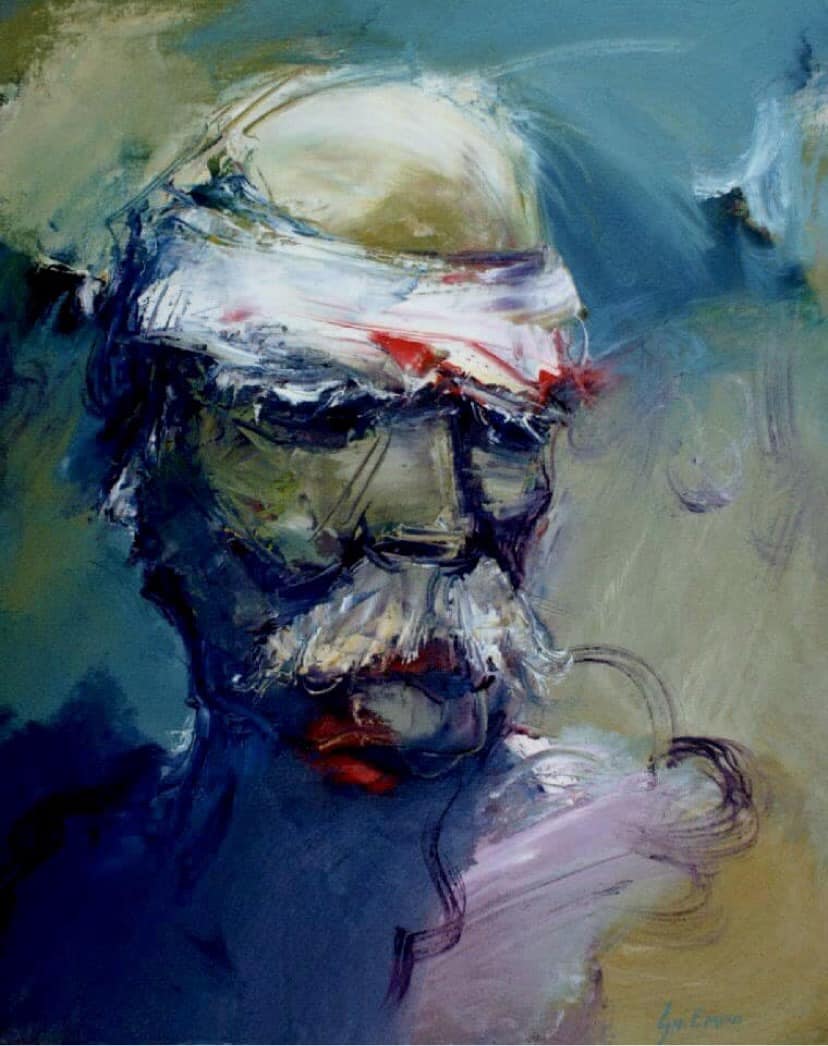Description of the Painting by Artist Shefqet Avdush Emini
Detailed Analysis of the Oil Painting
This oil painting is a powerful expressionist work that not only challenges traditional portraiture but also evokes deep emotions in the viewer. The colors, technique, and visual composition create a narrative that seems to go beyond the depicted figure, making it a manifestation of the emotional power of art.
1. Composition and Structure of the Painting
The portrait of the man occupies most of the frame, with an abstract background that does not provide much detail about the setting. This focuses the viewer’s attention on his expression and the expressionist technique used to bring this figure to life.
- Positioning of the figure: The head and shoulders dominate the composition, making the figure appear imposing and commanding.
- Perspective and angle: This is not a conventional portrait perspective; instead, the face seems to emerge from a mist of colors, immersed in an undefined background.
- Visual tension: The brushstrokes are bold, with vivid strokes creating a dynamic and unfinished feeling. This technique gives the figure a living, dramatic character, making it appear as if it is in motion or undergoing transformation.
2. Use of Colors and Their Impact
The colors in this painting are intense and filled with emotional tension. Expressionism, as an artistic movement, often uses colors to convey deep feelings, and this work is no exception.
- Blue and green background: These colors create a sense of coldness and distance. Blue is often associated with melancholy, while green can suggest calmness or an organic, natural presence.
- Yellow and golden tones: These give the face an eerie glow, making it seem like a figure reflecting an inner light or an important event in its life.
- Red on the bandage: This is the most dramatic element of the painting. The red suggests blood, pain, or a physical and emotional wound. This gives the figure a tragic dimension, making us wonder about its story.
- White as contrast: The white bandage on the forehead is a central element of the portrait, not only as a symbol of injury but also as a way to draw the viewer’s eye. The white, stained with red, creates a visual and emotional tension.
3. Brushstroke Technique and Sense of Movement
One of the most striking aspects of this painting is its expressionist technique. The brushstrokes are bold, with thick layers of paint that make the painting appear textured and deeply dimensional.
- Movement of the brush: The colors are applied loosely, creating an undefined effect that makes the figure seem merged with the background.
- Influence of abstract expressionism: The artist does not attempt to create a clean or realistic figure; instead, they allow the colors and brushstrokes to lead the emotion of the piece.
- Texture and density of the paint: The use of thick paint and blended colors makes the figure appear as an entity caught in inner turmoil.
4. Symbolism and Emotional Interpretation
This painting is more than just a portrait; it is a visual narrative that raises questions about the history and emotional state of the depicted figure.
- Is this an injured man or a warrior?
The bloodied bandage suggests a physical wound, but it can also symbolize an internal struggle or a difficult experience in his life. - Does he represent a historical figure or a universal image of suffering?
The exaggerated features and the way the portrait is constructed make him appear as a timeless figure, someone representing a broader story beyond his personal existence. - Facial expression: There is a sense of exhaustion, pain, and reflection in the man’s face. His eyes, though not fully defined, seem to carry a great emotional weight.
5. Conclusion: A Work of Emotional Power
This oil painting is a powerful example of expressionism in art. The combination of colors, brushstroke movements, and visual tension creates a work that is not just an image but an experience. The portrait of the man is more than just a figure; it is a powerful expression of human emotions, inner struggle, and the history that every person carries within them.
If we view this work as part of a larger story, it invites us to reflect on the nature of pain, strength, and human existence. This is what makes this painting unique and profoundly moving.
Support
Want to support the IUOMA with a financial gift via PayPal?
The money will be used to keep the IUOMA-platform alive. Current donations keep platform online till 1-october-2025. If you want to donate to get IUOMA-publications into archives and museums please mention this with your donation. It will then be used to send some hardcopy books into museums and archives. You can order books yourself too at the IUOMA-Bookshop. That will sponsor the IUOMA as well.
IMPORTANT: please use the friends/family option with donation on Paypal. That makes transaction fee the lowest.
This IUOMA platform on NING has no advertisings, so the funding is completely depending on donationsby members. Access remains free for everybody off course
Bewaren
Bewaren
Bewaren
Bewaren
Bewaren
Bewaren
Bewaren
Bewaren
Bewaren
LINKS
http://www.iuoma.org
IUOMA on Facebook
http://www.mail-art.de
http://www.mailart.be
Mail-Art on Wikipedia
Bookstore IUOMA
www.fluxus.org
Drawings Ruud Janssen
Mail Art Blog by Jayne
Fluxlist Europe
Privacy Revolution
fluxlist.blogspot.com/
TAM Rubberstamp Archive
MAIL-ART Projects
mail art addresses
Artistampworld
panmodern.com
MIMA-Italy
artistampmuseum
Papersizes Info
IUOMA Logo's
Mail Artists Index
Mailart Adressen
Maries Mailbox Blog
http://mailartarchive.com/
Mail-Interviews
http://www.crosses.net/
Ryosuke Cohen
http://heebeejeebeeland.blogspot.nl/
Your link here? Send me a message.
Videos
Birthdays
Birthdays Today
Birthdays Tomorrow
© 2025 Created by Ruud Janssen.
Powered by
![]()

You need to be a member of International Union of Mail-Artists to add comments!
Join International Union of Mail-Artists